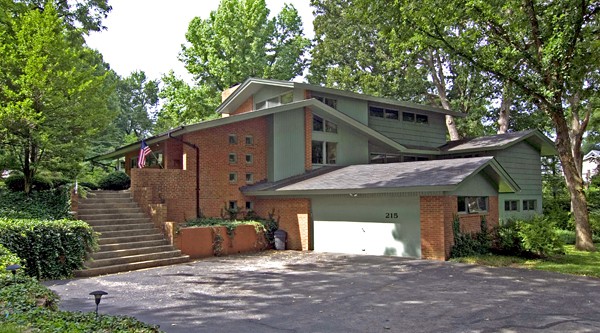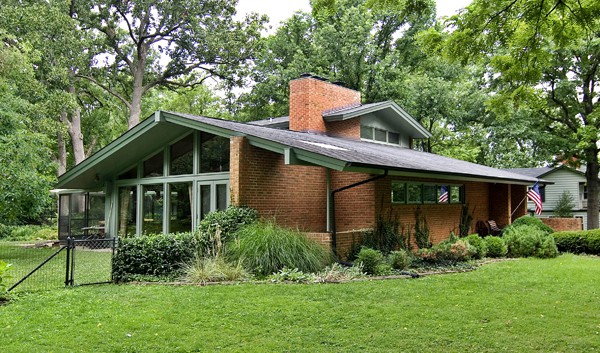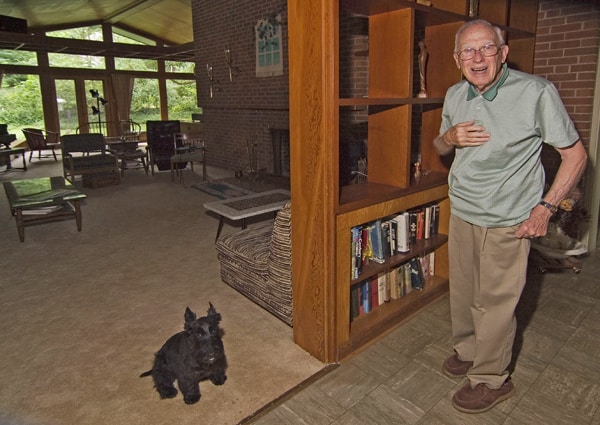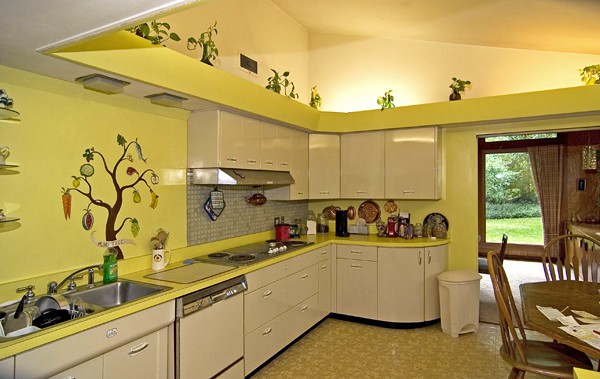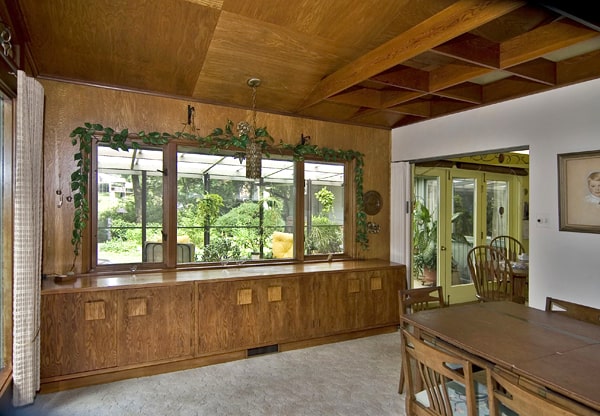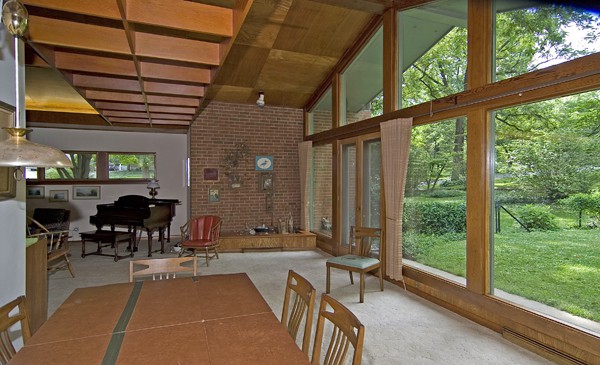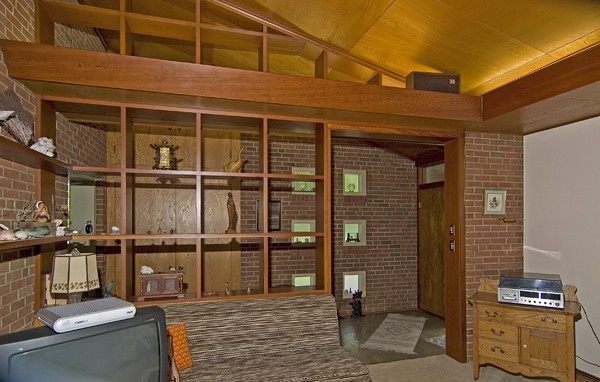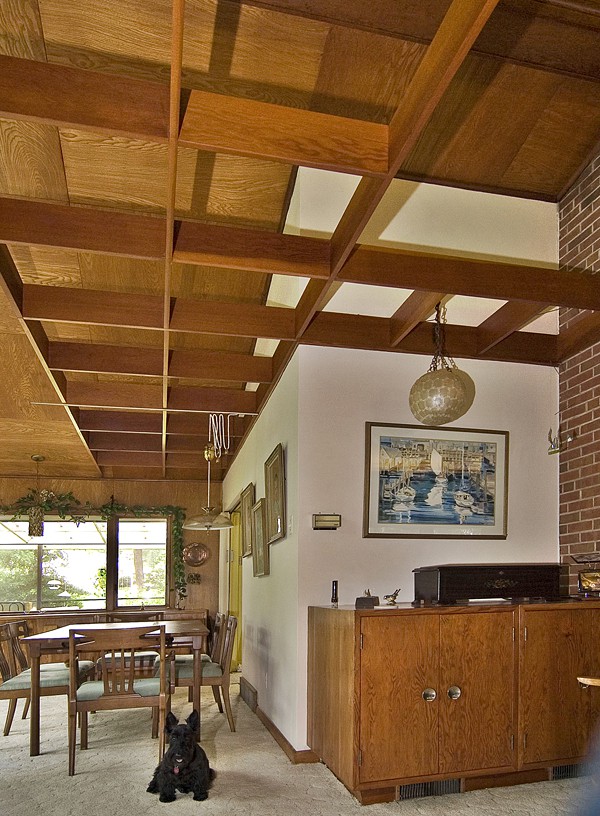As part of Mosby Building Art’s Anniversary, we had visited some of the projects that Scott Mosby’s father, Sam, had been a part of in the early days of the St. Louis remodeling company. This piece was originally published in July 2007. Hal Knight has since passed away and the custom mid-century modern home was bought by a new family in August 2013.
Sam Mosby’s first wife was Peggy, and her sister Nancy married Hal Knight, making Hal and Sam brothers-in-law. In 1954, Hal and Nancy bought property in Webster Park in Webster Groves, MO, and had a custom home designed for them. When it came time to build it, Sam Mosby was their only choice, and he being their brother-in-law had little to do with their decision.
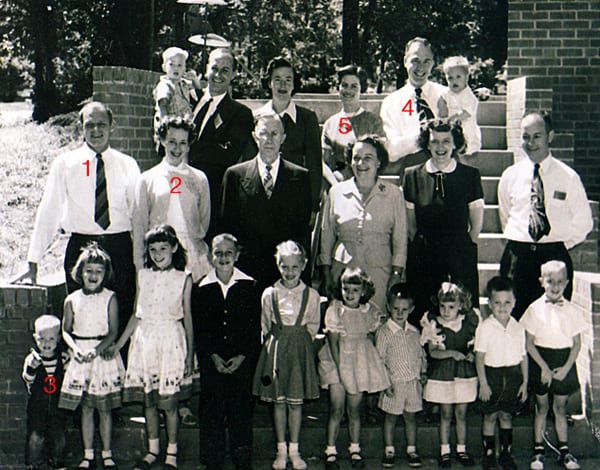
A family gathering at the newly-built home. 1. Sam Mosby 2. Peg Mosby 3. Scott Mosby 4. Hal Knight 5. Nancy Knight
Recently, Hal invited us over to see the house that Sam built over 53 years ago. His home is a unique, mid-century modern beauty with multiple levels and unexpected connections to their rambling property. Because his wife Nancy tended to be claustrophobic, she wanted to be able to see outdoor vistas wherever she looked, and that goal was accomplished with singular style and grace.
“Our house was designed by Erwin Knoesel*, an architect in downtown Webster Groves,” recalls Hal. “He was what they call a supervising architect; he didn’t just design it, he also wanted to see it built the way he wanted it built. Nan and Erwin worked together on all the details, and it became a rather complicated plan to bring to life. So, Sam was our only choice for building those plans.
“Sam was a good man, a hardworking man. We knew he was honest and trustworthy and that he would do a good job. Sam oversaw all the work on the house, bringing in subcontractors and such. But carpenter-wise, it was 2 or 3 men plus himself. He did most of the actual work, and it took about 7 to 8 months to finish it.”
Hal remembers the project starting off on a surprise note: “When they started excavation on it they had an unpleasant surprise. They ran into unexpected rock, so they had to get some of that out. But on the other hand, it’s a good thing because the house is sitting on a firm foundation.
“While he was building the new house, we lived in a little house about 2 blocks away. Nan would put our youngest into the baby buggy and walk up to watch the construction. I’d get there after working downtown and we’d take brooms and dustpans and clean up. We didn’t want Sam’s men to spend their time cleaning up. You don’t want to pay a carpenter for sweeping the floor. We also went around gathering up all the nails in the dirt. I’ve still got bottles of them. But you have to remember that we lived through the Depression days, when you didn’t scrap things.”
This “rather complicated plan” strikes a visitor as refreshingly functional and open, while closer inspection reveals a wealth of glorious details. Most rooms have built-in furniture, from sideboards to desks to a love seat with end table in the living room. Windows of untraditional shapes and sizes magically appear. The ceiling of the dining and living area is subtle patchwork of Japanese maple, and Scott Mosby relates a story his Dad told about them:
“They came as giant squares of plywood, and when Dad measured them, he learned not a single one of them was truly square. So, each panel had to first be cut down to exact square, which then made them smaller than originally specified. It all created a bit more work and time to execute, but you’d never know it to look at it. It’s beautiful.”
One of the more striking aspects of Hal’s home is that most everything is the original item first placed in 1954. The Geneva metal cabinets (“we did have them repainted”), tile backsplash, countertops and flooring of the kitchen are original. The moss green floor tile in the long hallway, light fixtures in every room, all bathroom fixtures and every custom window are just as Sam Mosby installed them in 1954. It’s striking that everything held up so perfectly and still looks pristine, to which Hal remarks, “We were very conscious of taking care of everything, because we love the place.”
With the cost of land and construction, the total for the 3,200 square foot custom home came to about $40,000. So, Hal, we have to ask: how’s the house holding up? “Very well, very well. After all, it’s going on 53 years old, so it’s holding up real well. We’ve put a new roof on, and added central air, but we haven’t had to do much else to the place.”
While admiring Hal’s still-pristine mid-century modern time capsule house, it becomes apparent that Scott Mosby’s goal of providing real value and enduring quality to homeowners was a value passed down from father to son. And examples of that family tradition can be seen all over the metropolitan St. Louis, serving as a reminder to 60 years of improving life one home at a time.
* In a unique full circle of fathers and sons, Scott Mosby eventually worked with the son of architect Erwin Knoesel on a new detached modern garage for their family home that Knoesel designed in 1938. Learn more about that project here.




